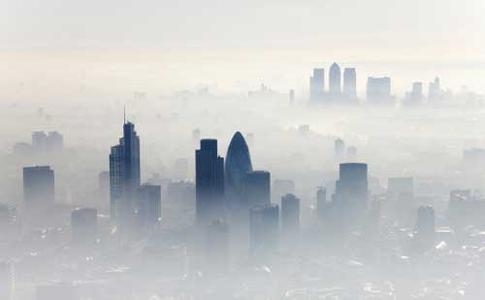

Researchers say breathing toxic air in the first two years of life linked to disorder
Pollution could be a factor in autism, researchers have found.
They say children with autism spectrum disorder (ASD) were more likely to have been exposed to higher levels of certain air toxics during their mothers' pregnancies and the first two years of life compared.
The find could help explain the rise in cases.
The investigation of children in southwestern Pennsylvania will be presented today at the American Association for Aerosol Research annual meeting in Orlando.
'Autism spectrum disorders are a major public health problem, and their prevalence has increased dramatically,' said Evelyn Talbott of Pitt Public Health, who led the research.
'Despite its serious social impact, the causes of autism are poorly understood.
'Very few studies of autism have included environmental exposures while taking into account other personal and behavioral risk factors.
'Our analysis is an addition to the small but growing body of research that considers air toxics as one of the risk factors for ASD.'
Dr. Talbott and her colleagues performed a population-based study of families with and without ASD living in six southwestern Pennsylvania counties.
The researchers found links between increased levels of chromium and styrene and childhood autism spectrum disorder, a condition that affects one in 68 children.
'This study brings us a step closer toward understanding why autism affects so many families in the Pittsburgh region and nationwide – and reinforces in sobering detail that air quality matters,' said Grant Oliphant, president of The Heinz Endowments.
'Our aspirations for truly becoming the most livable city cannot be realized if our children's health is threatened by dangerous levels of air toxics.
'Addressing this issue must remain one of our region's top priorities.'
Autism spectrum disorders are a range of conditions characterized by social deficits and communication difficulties that typically become apparent early in childhood.
Reported cases of ASD have risen nearly eight-fold in the last two decades.
While previous studies have shown the increase to be partially due to changes in diagnostic practices and greater public awareness of autism, this does not fully explain the increased prevalence.
Both genetic and environmental factors are believed to be partially responsible.
'Our results add to the growing body of evidence linking environmental exposures, such as air pollution, to ASD,' said Dr. Talbott.
'The next step will be confirming our findings with studies that measure the specific exposure to air pollutants at an individual level to verify these EPA-modeled estimates.'
研究:环境污染或可致自闭症
据《每日邮报》10月22日报道,研究者们发现,环境污染可能会导致自闭症。
他们说,患有自闭症谱系障碍(ASD)儿童更多地是在母亲孕期和出生头两年接触了高浓度的毒性空气污染物。
这一发现可以帮助解释儿童自闭病例的增加。
奥兰多举行的美国气溶胶研究协会(the American Association for Aerosol Research)年度会议将公布对宾夕法尼亚西南部儿童的调查结果。
该项研究的负责人,匹兹堡大学公共健康中心(Pitt Public Health)的伊芙琳·塔尔博特(Evelyn Talbott)说,“自闭症谱系障碍是重要的公共健康问题,而且发病率在急剧增加”。
“尽管自闭症谱系障碍产生严重的社会影响,但是人们对其成因却知之甚少。”
“自闭症研究通常考虑到的是个人或行为因素,只有极少数的研究将环境影响纳入在内。”'
“我们的研究是对成长中儿童患自闭症研究的补充,而且该项研究认为毒性空气污染物是自闭症谱系障碍的危险因素之一。”
塔尔博特博士和她的同事进行了一项以家庭为单位的研究,研究对象为宾夕法尼亚西南部6个县有自闭症和无自闭症家人的家庭。
研究者们发现,高浓度的铬和苯乙烯和68个儿童中就有一个患有的儿童自闭症相关联。
海因茨基金(The Heinz Endowments)主席格兰特•奥列芬特(Grant Oliphant)说:“这项研究让我们进一步了解到,为何匹兹堡地区乃至全国有如此之多的家庭有自闭症患者,也让我们清醒地认识到,空气质量非常重要”。
“如果儿童健康都受到空气中有毒物质的威胁,那成为最宜居的城市的愿望也就无法实现。”
“关注这一问题必将是匹兹堡地区最重要的工作之一。”
自闭症谱系障碍的特点是在儿童早期就表现出社会交往障碍和语言交流障碍。
过去二十年,已报告的自闭症病例增加了八倍。
尽管之前的研究显示,报告的自闭症病例的增加是由于诊断方法的改变和公众对自闭症的关注增加,但是这也无法详细解释这种上升的趋势。
基因和环境因素也被认为对自闭症病例的增加负有一定的责任。
塔尔博特博士说,我们的研究结果证明了环境接触,例如接触空气污染,会使成长中的儿童患上自闭症。
“下一步的研究将会证明接触空气污染物的研究结果。这项研究将测量个体接触的空气污染物,来核实环境保护署的预测结果。”
Copyright ©1999-2018
Chinanews.com. All rights reserved.
Reproduction in whole or in part without permission is prohibited.